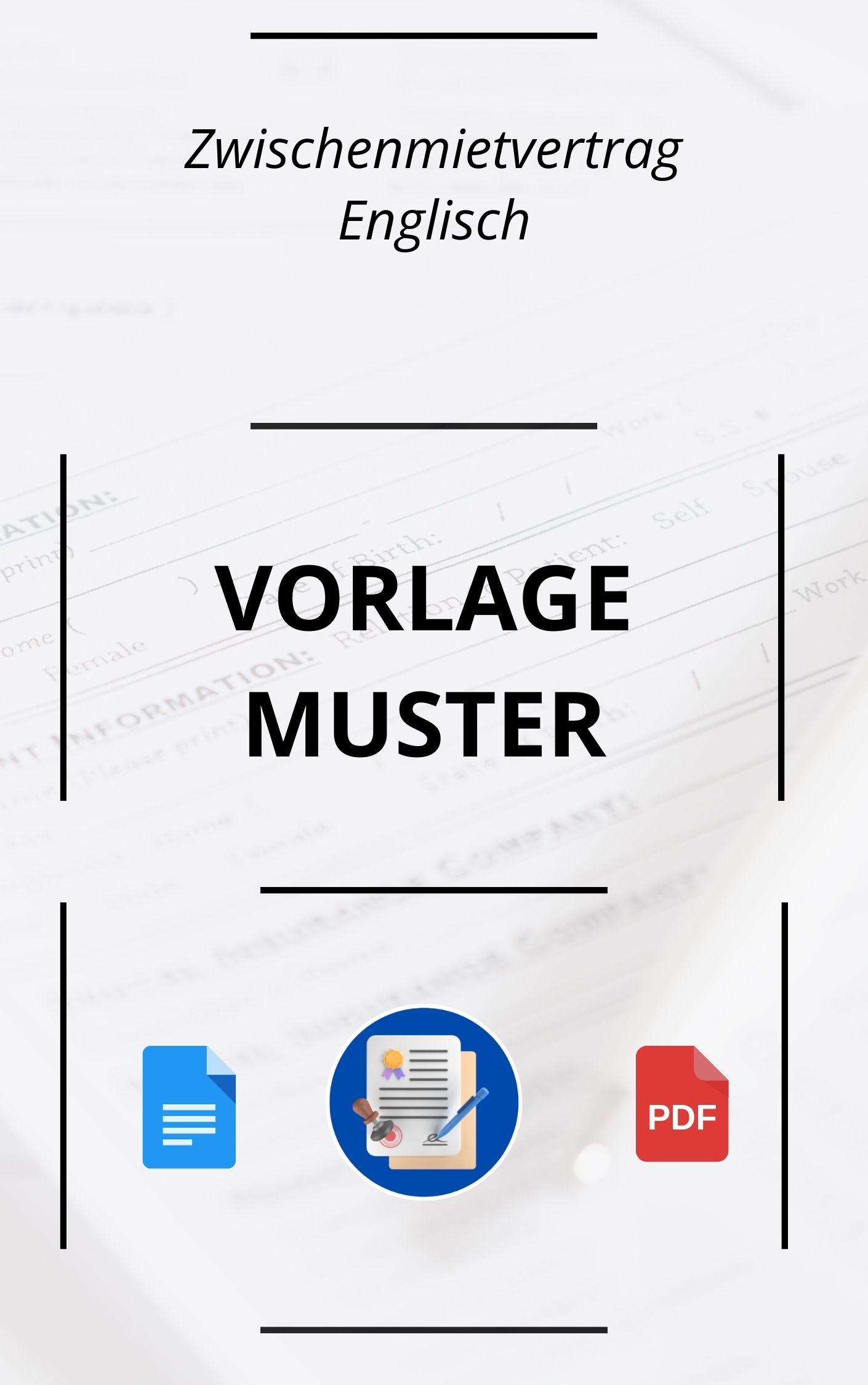Muster und Vorlage für Zwischenmietvertrag Englisch zur Erstellung und Anpassung – Öffnen im WORD– und PDF-Format

Vorlage Zwischenmietvertrag Englisch
- Parteien:
- [Vermieter]
- [Zwischenvermieter]
- [Zwischenmieter]
Beschreibung des Mietobjekts:
Das Mietobjekt ist eine [Art des Objekts] und befindet sich in [Adresse]. Es besteht aus [Anzahl der Zimmer/Bereiche] und verfügt über [besondere Merkmale/Ausstattung].
Vertragsdauer:
Der Zwischenmietvertrag beginnt am [Anfangsdatum] und endet am [Enddatum].
Mietzins und Zahlungsbedingungen:
Der monatliche Mietzins beträgt [Betrag] und ist bis zum [Zahlungsdatum] des jeweiligen Monats zu zahlen. Die Zahlungen erfolgen per [Zahlungsmethode].
Kaution:
Der Zwischenmieter leistet eine Kaution in Höhe von [Betrag]. Diese wird dem Vermieter als Sicherheit für etwaige Schäden oder ausstehende Zahlungen während der Mietdauer übergeben.
Pflichten und Verantwortlichkeiten:
- Der Zwischenmieter ist verpflichtet, das Mietobjekt ordnungsgemäß zu nutzen und zu pflegen.
- Der Zwischenmieter trägt alle entstehenden Kosten für den ordnungsgemäßen Betrieb des Mietobjekts, einschließlich Nebenkosten wie Strom, Wasser und Internet.
- Der Zwischenmieter haftet für Schäden, die während der Mietdauer am Mietobjekt entstehen, es sei denn, diese resultieren aus normalem Verschleiß oder höherer Gewalt.
Vorzeitige Beendigung:
Jede Partei hat das Recht, den Vertrag vorzeitig zu beenden, sofern eine schriftliche Mitteilung mit einer Frist von [Frist] vor dem gewünschten Beendigungsdatum erfolgt.
Kündigungsgründe:
- Die Parteien stimmen zu, dass eine vorzeitige Kündigung aus folgenden Gründen erfolgen kann: [Gründe].
- Im Falle der vorzeitigen Kündigung ist der Zwischenmieter verpflichtet, eine angemessene Entschädigung an den Vermieter zu zahlen.
Erneuerung:
Der Zwischenmietvertrag kann nach Ablauf der Vertragsdauer verlängert werden, sofern beide Parteien dies schriftlich vereinbaren.
Zusätzliche Klauseln:
[Hier können zusätzliche Klauseln oder Vereinbarungen aufgeführt werden, die für den Zwischenmietvertrag relevant sind.]
Gerichtsstand und Anwendbares Recht:
Für alle Streitigkeiten aus dem Zwischenmietvertrag gilt das [anwendbare Recht]. Der Gerichtsstand für etwaige Rechtsstreitigkeiten ist [Gerichtsstand].
Unterschriften:
[Vermieter] [Datum]
[Zwischenvermieter] [Datum]
[Zwischenmieter] [Datum]
Anhänge:
[Hier können eventuelle Anhänge oder Zusatzdokumente aufgeführt werden.]
Vorlage und Muster für Zwischenmietvertrag Englisch zur Anpassung und Erstellung im WORD– und PDF-Format
Mehr Muster und Vorlage für Zwischenmietvertrag Englisch
| Zwischenmietvertrag Englisch |
| PDF – WORD Format |
| Bewertung: ⭐⭐⭐⭐⭐ 4.37 |
| Ergebnisse – 1057 |
FAQ Zwischenmietvertrag Englisch
1. How do I write a sublease agreement in English?
Writing a sublease agreement in English requires careful attention to detail and understanding of the legal requirements. Here are the key elements to include:
- Term and Term Dates:
- Specify the start and end date of the sublease agreement.
- Parties:
- Identify the sublessor (original tenant), sublessee (new tenant), and the landlord.
- Rent:
- State the amount of rent and when it is due.
- Utilities and Expenses:
- Clarify who is responsible for paying utilities and any additional fees.
- Terms and Conditions:
- Outline any additional terms, such as pet policies, parking, or noise restrictions.
- Signatures:
- Ensure that all parties sign the sublease agreement.
2. Can I sublease my apartment without my landlord’s consent?
The rules regarding subleasing an apartment without the landlord’s consent vary depending on the jurisdiction and the terms of your lease agreement. It is always best to consult your lease agreement and local laws to ensure you are in compliance. In many cases, obtaining the landlord’s written consent is required.
3. What is the difference between a sublessor and a sublessee?
A sublessor is the original tenant who is renting out their property to a sublessee. The sublessee is the new tenant who rents the property from the sublessor for a specified period. The sublessor remains responsible for the terms outlined in the original lease agreement with the landlord.
4. Can I include a security deposit in a sublease agreement?
Yes, you can include a security deposit in a sublease agreement. The amount and terms of the security deposit should be clearly stated in the agreement, including when it will be returned and what deductions may be made for damages or unpaid rent.
5. What happens if the sublessee doesn’t pay rent?
If the sublessee fails to pay rent, the sublessor is still responsible for paying the full rent amount to the landlord. The sublessor can take legal action against the sublessee to recover the unpaid rent and any other damages incurred.
6. Can I sublease my apartment for a shorter period than my original lease?
In most cases, you can sublease your apartment for a shorter period than your original lease. However, you should review your lease agreement and consult with your landlord to ensure you are not violating any terms or regulations. It is also essential to include the correct dates in the sublease agreement to avoid any confusion.
7. Can I sublease only a portion of my apartment?
Yes, you can sublease only a portion of your apartment if your lease agreement and local laws allow it. However, it is crucial to obtain your landlord’s consent and clearly define the specific areas or rooms that are being subleased in the agreement.
8. What is the difference between a sublease and an assignment?
A sublease occurs when a tenant rents out their property to another tenant for a specified period. The original tenant remains responsible for the terms of the lease agreement with the landlord. An assignment, on the other hand, transfers the lease agreement entirely from the original tenant to a new tenant, relieving the original tenant of any further obligations.
9. Can the landlord raise the rent during a sublease?
In most cases, the landlord cannot raise the rent during a sublease unless there are specific provisions in the original lease agreement that allow for rent increases. It is essential to review your lease agreement to understand the terms regarding rent adjustments.
10. Can I terminate a sublease agreement early?
Terminating a sublease agreement early generally requires the agreement of all parties involved, including the sublessor, sublessee, and landlord. It is best to consult the terms of your lease agreement and speak with all parties to negotiate an early termination if necessary.
11. Can I share a subleased apartment with roommates?
In many cases, you can share a subleased apartment with roommates if it is allowed by your lease agreement and local laws. However, it is crucial to obtain your landlord’s consent and ensure that all parties are listed and sign the sublease agreement.
12. Can I sublease an apartment if I am just a roommate?
If you are only a roommate and not the primary tenant on the lease agreement, you will need the consent of the primary tenant and the landlord to sublease the apartment. It is essential to communicate with all parties involved and follow the necessary legal procedures.
13. Can the landlord refuse to allow me to sublease my apartment?
In some cases, the landlord may have the right to refuse a sublease if it violates the terms of the lease agreement or local laws. It is crucial to review your lease agreement and consult your landlord before proceeding with a sublease to avoid any legal issues.
14. What should I do if I want to sublease my apartment but cannot find a suitable sublessee?
If you are unable to find a suitable sublessee for your apartment, it is essential to communicate with your landlord and explore alternative options. Your landlord may have suggestions or requirements for finding a replacement tenant, or you may need to consider other options such as early termination or finding a roommate instead.
15. How can I protect myself and my rights as a sublessor or sublessee?
To protect yourself and your rights as a sublessor or sublessee, it is crucial to:
- Have a written sublease agreement that clearly outlines all terms and conditions.
- Obtain the necessary consent from the landlord and ensure all parties sign the agreement.
- Understand and follow all legal requirements and regulations.
- Keep accurate records of rent payments and communication between all parties.
- Address any issues or disputes promptly and in accordance with the agreed-upon procedures.
By following these steps and seeking legal advice if necessary, you can help ensure a smooth subleasing experience.
